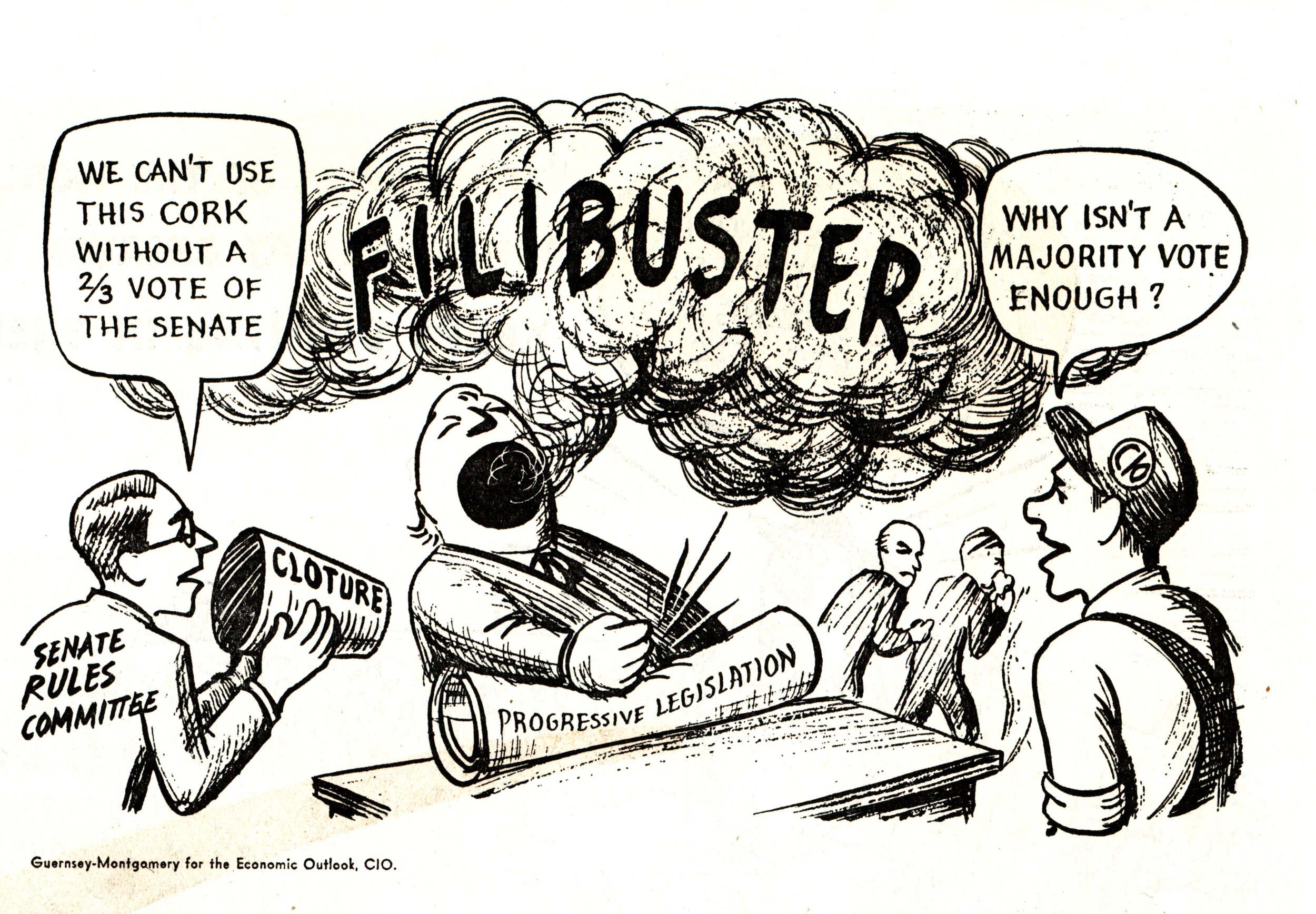Weaponized procrastination: this is the filibuster
Written by Lakshmi Adiga
Once President Joe Biden was elected, many voters looked forward to the new Democrat majority’s policy and legislative goals, a welcome direction away from Trump-era policies. However, the USA’s two-party political system has once again created a roadblock for political progress: the Senate filibuster. After Biden’s numerous statements on the filibuster block from the beginning of his presidency to the latest debt limit crisis, many people are still left wondering, what actually is the filibuster, and why should I care? Also … what even is going on with the debt limit?
Image via Tobias Higbie / Flickr
What is the filibuster?
The filibuster is a Senate rule — any piece of legislation requires 60 votes out of the 100 senators to be passed. What? We’ve all been taught that legislation only needs a majority vote to be passed, so 51 votes should do the trick. However, there’s a step before the actual Senate floor votes on a bill — the debate. Senators have the right to unlimited debate until 60 senators, a supermajority, decide to start voting on the legislation. Invoking this right to debate in order to delay or prevent a vote on legislation is what’s known as filibustering.
Why should I care?
Political parties have become extremely partisan in these past few decades; little policy is agreed upon between Republicans and Democrats, and certainly not the large scale reforms that Biden proposes. Although Democrats have a majority in the Senate, it’s not a supermajority. The minority Republican Party can easily block legislation by invoking the filibuster, allowing debate to drone on until the vote is effectively prevented, halting any possible progress in Congress. The latest crisis with the debt limit has been a stunning show of just how stuck the Senate is.
Debt Ceiling Rally | image via The Leadership Conference on Civil and Human Rights / Flickr
If you hadn’t known already, the U.S. is in debt and has been since the Revolutionary War. The debt limit is the amount of money that Congress approves for the U.S. to borrow in order to meet its financial needs and obligations. If Congress doesn’t approve the borrowing of money, the U.S. government is effectively broke. It would default on numerous financial responsibilities such as Social Security and Medicare, weakening economic security and plunging the country into a recession not dissimilar to the one in 2011.
So what’s the best way for Republicans to threaten the majority Democrats? By filibustering the ceiling for the debt limit.
Since Sept. 27, Mitch McConnell and the minority Republican Party have been blocking the vote to increase the debt limit. They have thrown the U.S. into an economic limbo, which leaves the USAmerican people’s financial security hanging on the line, effectively using the consequences as political propaganda. By forcing the Democrats to make the debt ceiling partisan — completely Democrat-run — Republicans are able to blame the generational burden of the $30 trillion debt on the Democrats, thus giving the Republican Party an edge during the 2022 midterm elections.
As a consequence of the Democratic Party’s refusal to give in plus dwindling time, McConnell proposes to press pause on the filibustering and allow the Democrats to raise the debt limit, postponing eventual disaster.
However, the Republican Party isn’t planning on relinquishing this form of political blackmail. This tenuous peace will only last until Dec. 3 when the filibustering will start up all over again, unless either a bipartisan move is made to end the crisis or the last resort is invoked.
So the system isn’t working… now what? The nuclear option.
We’ve all been victims of procrastination at one point or another, finding ourselves at a roadblock in our work with it seeming like nothing but a looming deadline could get us out. However, the Senate’s procrastination of the filibuster is weaponized, an act of violence against the legal process that removes the concept of a deadline entirely.
The only way through a filibuster block sounds even more brutal: the nuclear option.
The nuclear option is a procedure to end the Senate rule which enables the filibuster. It doesn’t seem so nuclear until you realize that the Senate has operated using the principles of tradition and bipartisanship since its founding to protect the minority opinion, something the nuclear option would decimate. Previously, the nuclear option has been invoked to lower the required vote from 60 to 51 for executive branch appointees and Supreme Court nominees, and now representatives fear another dramatic precedent to be set as Biden inches toward using the nuclear option to end the threat of the debt limit crisis.
Image via Adam Schultz / Flickr
Washington, D.C. is famed for getting nothing done — each policy experiences setback after setback, and as a result, the U.S. public sees little of the change promised by politicians. To confront the filibuster, Biden must first confront the extreme polarity in the Senate and preserve the integrity of its purpose: to ensure bipartisanship and cooperation of political thought in the U.S. government. With the midterm elections coming up, the Democrats may lose their majority in the Senate, making it even harder for the Democratic Party to fulfill its campaign promises to the U.S. people.
Cover image via Kyle Glenn / Unsplash













